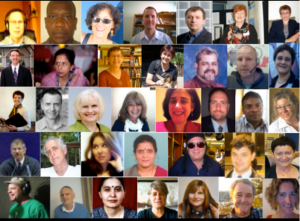- The question we most commonly ask is the “what” question-what subjects shall we teach?
- When the conversation goes a bit deeper, we ask the “how” question-what methods and techniques are required to teach well?
- Occasionally, when it goes deeper still, we ask the “why” question-for what purpose and to what ends do we teach?
- But seldom, if ever, do we ask the “who” question-who is the self that teaches? How does the quality of my selfhood form-or deform-the way I relate to my students, my subject, my colleagues, my world? How can educational institutions sustain and deepen the selfhood from which good teaching comes?
Parker Palmer, The Courage To Teach
Beginning my position as a new Head of School, I opened our first full staff professional learning session with the above quote from educator Parker Palmer. Determined to shift from my voice to our voices as quickly as possible, I moved almost immediately to a learning activity modified from one Palmer describes later in his book.
Imagine a moment when everything was going right for you as a teacher; when your teaching was so good you felt you were born to teach, and you knew you were making a difference for students.
The happy social buzz of first day greetings, which had begun shortly before our learning session as we arrived for a welcome breakfast, continued. The ebullient, celebratory mood of greeting friends and colleagues after a summer apart gently moved deeper, broaching seldom asked questions about qualities of teachers that lie at the heart of learning; transcending curriculum, instruction, and assessment.
After a short time, I invited teachers and staff who wanted to do so to share with the whole group; acknowledging teachers’ humility and reluctance to speak in a manner that might feel like boasting. The stories inspired. Some were about individual students’ triumphs in overcoming challenge or adversity; some about entire classes making remarkable progress; and others about a key attribute of a teacher that positively impacted students year after year. We applauded each and every speaker, beginning our year with appreciation.
We then moved just a bit deeper as Parker Palmer encourages us to do. I asked teachers to focus, not on their own celebratory stories, but on those of their colleagues, identifying the gifts, the personal strengths and qualities within their colleagues, that bring success. Colleagues talked about care, the ability to listen, patience, perseverance in the face of challenge, and grounding in enduring values. They spoke, meaningfully and thoughtfully, not about skills or specific knowledge, but rather about qualities that enable teachers to connect and build relationships with students. Intuitively, teachers reached beyond themselves, emphasizing the need to understand our students, equating greatness in teaching to connection with students; as individuals, as a class, and as a school-wide community of learners.
As we concluded the session, I shared with teachers my commitment to being present in classrooms regularly, not to judge, but to engage, learn, appreciate, and support. In time, I plan to offer ongoing non-judgemental feedback to prompt teacher reflection. Yet in the beginning, as teachers at my new school and I get to know each other and develop trusting relationships, I choose to refrain from offering feedback and instead to focus almost exclusively on presence and heartfelt appreciation. As the Head of School of an independent school, in which the format for teacher evaluation is not mandated by a district or the state, I have that freedom. I can take some time, engage with teachers, and collaboratively design a feedback framework emphasizing growth.
In the past I interpreted, or more likely misinterpreted, educational research as indicating that paradoxically praise is judgmental and disrespectful of teachers’ and students’ abilities to reflect on their own learning; successes and mistakes alike. Teachers opened my eyes; sharing the pain of giving heart and soul and only infrequently, if at all, receiving appreciation from supervisors. I have heard from teachers about how disconcerting it is to feel as if one is “on stage” as a supervisor, even a caring supervisor, observes. Trained to focus on learning from mistakes, teachers often, almost obsessively, analyze what went wrong in a lesson,while glossing over what went right. We frequently see ourselves through intensely critical lenses and imagine those observing us do as well. We too often neglect to celebrate our successes, inadvertently missing out on the potential to build from our strengths.
As Parker Palmer boldly asserts, it takes courage to teach. That courage deserves appreciation.
And so, I reach out to teachers in my own school, and to colleagues more broadly wondering about ways of structuring appreciative, reflective exploration of teaching practice. If you were able to structure a system of feedback for professionals to promote growth, in lieu of formal evaluation, what process would you use? What components would you include? What would be helpful for you?













